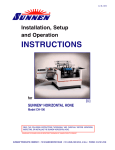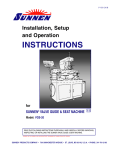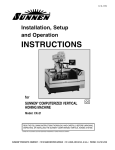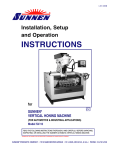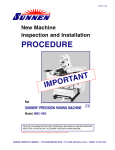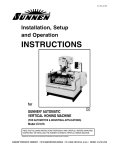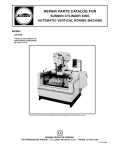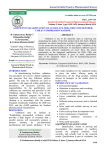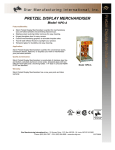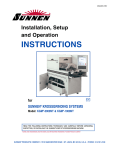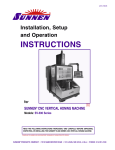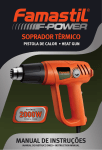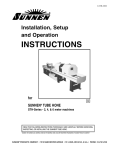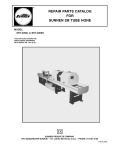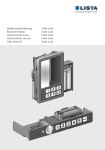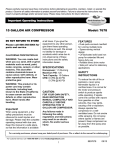Download safety instructions
Transcript
I-PF-151B Installation, Setup and Operation INSTRUCTIONS for SUNNEN® HONING OIL FILTER UNIT Model: PF-150 READ THE FOLLOWING INSTRUCTIONS THOROUGHLY AND CAREFULLY BEFORE UNPACKING, INSPECTING, OR INSTALLING THE SUNNEN® PF-150 HONING OIL FILTER UNIT. “SUNNEN AND THE SUNNEN LOGO ARE REGISTERED TRADEMARKS OF SUNNEN PRODUCTS COMPANY.” SUNNEN ® PRODUCTS COMPANY • 7910 MANCHESTER AVENUE • ST. LOUIS, MO 63143, U.S.A. • PHONE: 314-781-2100 GENERAL INFORMATION The Sunnen® equipment has been designed and engineered for a wide variety of parts within the capacity and limitation of the equipment. With proper care and maintenance this equipment will give years of service. READ THE FOLLOWING INSTRUCTIONS CAREFULLY AND THOROUGHLY BEFORE UNPACKING, INSPECTING, OR INSTALLING THIS EQUIPMENT. IMPORTANT: Read any supplemental instructions BEFORE installing this equipment. These supplemental instructions give you important information to assist you with the planning and installation of your Sunnen equipment. Sunnen Technical Service Department is available to provide telephone assistance for installation, programming, & troubleshooting of your Sunnen equipment. All support is available during normal business hours, 8:00 AM to 4:30 PM Central Time. Emergency breakdown support is available on a 24 hour / 7 day basis. Review all literature provided with your Sunnen equipment. This literature provides valuable information for proper installation, operation, and maintenance of your equipment. Troubleshooting information can also be found within the Instructions. If you cannot find what you need, call for technical support. Where applicable, programming information for your Sunnen equipment is also included. Most answers can be found in the literature packaged with your equipment. Help us help you. When ordering parts, requesting information, or technical assistance about your equipment, please have the following information available: • Have ALL MANUALS on hand. The Customer Services Representative or Technician will refer to it. • Have Model Number and Serial Number printed on your equipment Specification Nameplate. • Where Applicable: Have Drive model and all nameplate data. Motor type, brand, and all nameplate data. For Troubleshooting, additional information may be required: • Power distribution information (type - delta, wye, power factor correction; other major switching devices used, voltage fluctuations) • Installation Wiring (separation of power & control wire; wire type/class used, distance between drive and motor, grounding). • Use of any optional devices/equipment between the Drive & motor (output chokes, etc.). For fast service on your orders call: Sunnen Automotive Customer Service toll free at: 1-800-772-2878 Sunnen Industrial Customer Service toll free at: 1-800-325-3670 Customers outside the USA, contact your local authorized Sunnen Distributor. Additional information available at: http://www.sunnen.com or e-mail: [email protected] NOTE: Sunnen reserves the right to change or revise specifications and product design in connection with any feature of our products contained herein. Such changes do not entitle the buyer to corresponding changes, improvements, additions, or replacements for equipment, supplies or accessories previously sold. Information contained herein is considered to be accurate based on available information at the time of printing. Should any discrepancy of information arise, Sunnen recommends that user verify the discrepancy with Sunnen before proceeding. ESD PREVENTION REVIEW Let's review the basics of a sound static control system and its effective implementation. First, in the three step plan: 1. Always ground yourself when handling sensitive components or assemblies. 2. Always use a conductive or shielded container during storage or transportation. These materials create a Faraday cage which will isolate the contents from static charges. 3. Open ESD safe containers only at a static safe work station. At the static safe work station, follow these procedures before beginning any work: A. Put on your wrist strap or foot grounding devices. B. Check all grounding cords to make sure they are properly connected to ground, ensuring the effective dissipation of static charges. C. Make sure that your work surface is clean and clear of unnecessary materials, particularly common plastics. D. Anti-static bubble wrap has been included for use at the machine when an ESD safe workstation is not available. You are now properly grounded and ready to begin work. Following these few simple rules and using a little common sense will go a long way toward helping you and your company in the battle against the hazards of static electricity. When you are working with ESD sensitive devices, make sure you: GROUND ISOLATE NEUTRALIZE ii SUNNEN® LIMITED PRODUCT WARRANTY Sunnen® Products Company and its subsidiaries (SPC) warrant that all new SPC honing machines, gaging equipment, tooling, and related equipment will be free of defects in material and/or workmanship for a period of one year from the date of original shipment from SPC. Upon prompt notification of a defect during the one-year period, SPC will repair, replace, or refund the purchase price, with respect to parts that prove to be defective (as defined above). Any equipment or tooling which is found to be defective from improper use will be returned at the customer's cost or repaired (if possible) at customer's request. Customer shall be charged current rates for all such repair. Prior to returning any SPC product, an authorization (RMA#) and shipping instructions must be obtained from the Customer Service Department or items sent to SPC will be returned to the customer. Warranty Limitations and Exclusions This Warranty does not apply to the following: • Normal maintenance items subject to wear and tear: (belts, fuses, filters, etc). • Damages resulting from but not limited to: › Shipment to the customer (for items delivered to customer or customer's agent F.O.B., Shipping Point) › Incorrect installation including improper lifting, dropping and/or placement › Incorrect electric power (beyond +/- 10% of rated voltage) including intermittent or random voltage spikes or drops › Incorrect air supply volume and/or pressure and/or contaminated air supply › Electromagnetic or radio frequency interference from surrounding equipment (EMI, RFI) › Storm, lightning, flood or fire damage › Failure to perform regular maintenance as outlined in SPC manuals › Improper machine setup or operation causing a crash to occur › Misapplication of the equipment › Use of non-SPC machines, tooling, abrasive, fixturing, coolant, repair parts, or filtration › Incorrect software installation and/or misuse › Non-authorized customer installed electronics and/or software › Customer modifications to SPC software THE LIMITED WARRANTY DESCRIBED HEREIN IS EXPRESSLY IN LIEU OF ALL ANY OTHER WARRANTIES. SPC MAKES NO REPRESENTATION OR WARRANTY OF ANY OTHER KIND, EXPRESS OR IMPLIED, WHETHER AS TO MERCHANTABILITY, FITNESS FOR A PARTICULAR PURPOSE OR ANY OTHER MATTER. SPC IS NOT RESPONSIBLE FOR THE IMPROPER USE OF ANY OF ITS PRODUCTS. SPC SHALL NOT BE LIABLE FOR DIRECT, INDIRECT, INCIDENTAL, OR CONSEQUENTIAL DAMAGES INCLUDING BUT NOT LIMITED TO: LOSS OF USE, REVENUE, OR PROFIT. SPC ASSUMES NO LIABILITY FOR PURCHASED ITEMS PRODUCED BY OTHER MANUFACTURERS WHO EXTEND SEPARATE WARRANTIES. REGARDLESS OF ANY RIGHTS AFFORDED BY LAW TO BUYER, SPC's LIABILITY, IF ANY, FOR ANY AND ALL CLAIMS FOR LOSS OR DAMAGES WITH RESPECT TO THE PRODUCTS, AND BUYER'S SOLE AND EXCLUSIVE REMEDY THEREFORE, SHALL IN ALL EVENTS BE LIMITED IN AMOUNT TO THE PURCHASE PRICE OF THAT PORTION OF THE PRODUCTS WITH RESPECT TO WHICH A VALID CLAIM IS MADE. Shipping Damages Except in the case of F.O.B., Buyer's destination shipments, SPC will not be liable for any settlement claims for obvious and/or concealed shipping damages. The customer bears the responsibility to unpack all shipments immediately and inspect for damage. When obvious and/or concealed damage is found, the customer must immediately notify the carrier's agent to make an inspection and file a claim. The customer should retain the shipping container and packing material. SUNNEN® SOFTWARE LICENSE AGREEMENT This document is a Legal Agreement between you, as user and licensee (Licensee), and Sunnen® Products Company (SPC) with respect to preprogrammed software (Software) provided by SPC for use on SPC Equipment. By using the Software, you, as Licensee, agree to become bound by the terms of this Agreement. In consideration of payment of the license fee (License Fee) which is part of the price evidenced by your receipt (Receipt), SPC grants to you as Licensee a non-exclusive right, without right to sub-license, to use the particular copy of the SPC Software licensed hereunder only on the particular equipment sold with the Software. SPC reserves all rights including rights not otherwise expressly granted, and retain title and ownership to the Software including all subsequent copies or updates in any media. The Software and all accompanying written materials are covered by copyrights owned by SPC. If supplied on removable media (floppy disk), you, as Licensee, may copy the Software only for back up purposes; or you may request that SPC copy the Software for you for the same purposes. All other copying of the Software or of the accompanying written materials is expressly forbidden and is in violation of the Agreement. The Software and accompanying written materials (including the user's manual, if any) are provided in an "as is" condition without warranty of any kind including the implied warranties of merchantability and fitness for a particular purpose, even if SPC has been advised of this purpose. SPC specifically does not warrant that it will be liable as a result of the operation of the Software for any direct, indirect, consequential or accidental damages arising out of the use of or inability to use such product even if SPC has been advised of the possibility of such use. It is recognized that some states do not allow the exclusion or limitation of liability for consequential or accidental damages and to the extent this is true, the above limitations may not apply. Any alteration or reverse engineering of the software is expressly forbidden and is in violation of this agreement. SPC reserves the right to update the software covered by this agreement at any time without prior notice and any such updates are covered by this agreement. iii SAFETY INSTRUCTIONS READ FIRST This machine, like any machine tool, may be dangerous if used improperly. Please read all warnings and instructions before attempting to use this machine.1 DO NOT remove or defeat any safety device. Always wear eye protection when operating this machine. DO NOT attempt any repair or maintenance procedure beyond those described in this book. Contact your Sunnen Service Representative for repairs not covered in this book. Indicates CE version ONLY. 1 DO NOT touch electrical components until main input power has been turned off and CHARGE lamps are extinguished. WARNING: The capacitors are still charged and can be quite dangerous. INTRODUCTION Sunnen PF-150 Honing Oil Filter Unit is designed to filter grit and metal particles from coolant supply on following model of Sunnen Precision Honing Machines: LBB-1660 MBB-1660 MBB-1650* MBB-1690* MBB-1670* MBH-2500* MBB-1680* MBH-2570* MBH-2580* *Out of Production Unit is a 100% filter in that it filters all of coolant that passes through it; none is bypassed unless you intentionally bypass it. In operation, unit's pump sucks dirty coolant from machine reservoir and pushes this dirty coolant through a 5-micron paper filter element. Clean filtered coolant is then returned to machine. Unit pumps an oversupply of filtered coolant to machine. This oversupply of coolant is bled off to machine reservoir by overflowing receiving bucket or by action of optional low-pressure relief valve (MBB-1620 Pump Bypass Kit), depending upon which method of installation is employed. As filter canister fills with sludge being removed from coolant, an ample supply of filtered coolant continues to be supplied to machine. Over 75 cubic inches (1.2 liters) of sludge can accumulate in canister without interfering with filtering operation. When filter element clogs, coolant supply to machine is shut off. 5-micron filter element can be changed easily in a few minutes, restoring flow filtered coolant. iv TABLE OF CONTENTS Page General Information . . . . . . . . . . . . . . . . . . . . . . . . . . . . . . . . . . . . . . . . . . . . . . . . . . . . . . . . . . . . . . . . . . . . . . ii ESD Prevention Review . . . . . . . . . . . . . . . . . . . . . . . . . . . . . . . . . . . . . . . . . . . . . . . . . . . . . . . . . . . . . . . . . . . ii Sunnen® Limited Product Warranty . . . . . . . . . . . . . . . . . . . . . . . . . . . . . . . . . . . . . . . . . . . . . . . . . . . . . . . . . . iii Sunnen® Software License Agreement . . . . . . . . . . . . . . . . . . . . . . . . . . . . . . . . . . . . . . . . . . . . . . . . . . . . . . . iii Introduction . . . . . . . . . . . . . . . . . . . . . . . . . . . . . . . . . . . . . . . . . . . . . . . . . . . . . . . . . . . . . . . . . . . . . . . . . . . . iv Safety Instructions . . . . . . . . . . . . . . . . . . . . . . . . . . . . . . . . . . . . . . . . . . . . . . . . . . . . . . . . . . . . . . . . . . . . . . . iv Table Of Contents . . . . . . . . . . . . . . . . . . . . . . . . . . . . . . . . . . . . . . . . . . . . . . . . . . . . . . . . . . . . . . . . . . . . . . . v General Information & Specifications . . . . . . . . . . . . . . . . . . . . . . . . . . . . . . . . . . . . . . . . . . . . . . . . . . . . . . . . vi INSTALLATION General . . . . . . . . . . . . . . . . . . . . . . . . . . . . . . . . . . . . . . . . . . . . . . . . . . . . . . . . . . . . . . . . . . . . . . . . . . . . . . . . . . Suggested Toolin . . . . . . . . . . . . . . . . . . . . . . . . . . . . . . . . . . . . . . . . . . . . . . . . . . . . . . . . . . . . . . . . . . . . . . . . . . Unpacking . . . . . . . . . . . . . . . . . . . . . . . . . . . . . . . . . . . . . . . . . . . . . . . . . . . . . . . . . . . . . . . . . . . . . . . . . . . . . . . . Installation . . . . . . . . . . . . . . . . . . . . . . . . . . . . . . . . . . . . . . . . . . . . . . . . . . . . . . . . . . . . . . . . . . . . . . . . . . . . . . . Optinal Installation . . . . . . . . . . . . . . . . . . . . . . . . . . . . . . . . . . . . . . . . . . . . . . . . . . . . . . . . . . . . . . . . . . . . . . . . . Electrical Requirements . . . . . . . . . . . . . . . . . . . . . . . . . . . . . . . . . . . . . . . . . . . . . . . . . . . . . . . . . . . . . . . . . . . . . Electrical Connections . . . . . . . . . . . . . . . . . . . . . . . . . . . . . . . . . . . . . . . . . . . . . . . . . . . . . . . . . . . . . . . . . . . . . . Operational Check . . . . . . . . . . . . . . . . . . . . . . . . . . . . . . . . . . . . . . . . . . . . . . . . . . . . . . . . . . . . . . . . . . . . . . . . . 1 1 1 2 3 6 6 7 PREPARING FOR OPERATION General . . . . . . . . . . . . . . . . . . . . . . . . . . . . . . . . . . . . . . . . . . . . . . . . . . . . . . . . . . . . . . . . . . . . . . . . . . . . . . . . . . 9 Major Components. . . . . . . . . . . . . . . . . . . . . . . . . . . . . . . . . . . . . . . . . . . . . . . . . . . . . . . . . . . . . . . . . . . . . . . . . 9 Safety Symbols . . . . . . . . . . . . . . . . . . . . . . . . . . . . . . . . . . . . . . . . . . . . . . . . . . . . . . . . . . . . . . . . . . . . . . . . . . . . 9 SETUP & OPERATION General . . . . . . . . . . . . . . . . . . . . . . . . . . . . . . . . . . . . . . . . . . . . . . . . . . . . . . . . . . . . . . . . . . . . . . . . . . . . . . . . . 11 Safety Precautions . . . . . . . . . . . . . . . . . . . . . . . . . . . . . . . . . . . . . . . . . . . . . . . . . . . . . . . . . . . . . . . . . . . . . . . . 11 Operating Hints . . . . . . . . . . . . . . . . . . . . . . . . . . . . . . . . . . . . . . . . . . . . . . . . . . . . . . . . . . . . . . . . . . . . . . . . . . . 11 Start-Up of Honing Operation . . . . . . . . . . . . . . . . . . . . . . . . . . . . . . . . . . . . . . . . . . . . . . . . . . . . . . . . . . . . . . . 12 ROUTINE MAINTENANCE General . . . . . . . . . . . . . . . . . . . . . . . . . . . . . . . . . . . . . . . . . . . . . . . . . . . . . . . . . . . . . . . . . . . . . . . . . . . . . . . . . Cleaning . . . . . . . . . . . . . . . . . . . . . . . . . . . . . . . . . . . . . . . . . . . . . . . . . . . . . . . . . . . . . . . . . . . . . . . . . . . . . . . . Coolant Line . . . . . . . . . . . . . . . . . . . . . . . . . . . . . . . . . . . . . . . . . . . . . . . . . . . . . . . . . . . . . . . . . . . . . . . . . . . . . Filter Element . . . . . . . . . . . . . . . . . . . . . . . . . . . . . . . . . . . . . . . . . . . . . . . . . . . . . . . . . . . . . . . . . . . . . . . . . . . . Filter Canister . . . . . . . . . . . . . . . . . . . . . . . . . . . . . . . . . . . . . . . . . . . . . . . . . . . . . . . . . . . . . . . . . . . . . . . . . . . . Low Pressure Relief Valve (Opt.) . . . . . . . . . . . . . . . . . . . . . . . . . . . . . . . . . . . . . . . . . . . . . . . . . . . . . . . . . . . . . Pump Seal . . . . . . . . . . . . . . . . . . . . . . . . . . . . . . . . . . . . . . . . . . . . . . . . . . . . . . . . . . . . . . . . . . . . . . . . . . . . . . . 13 13 13 13 13 14 15 TROUBLESHOOTING General . . . . . . . . . . . . . . . . . . . . . . . . . . . . . . . . . . . . . . . . . . . . . . . . . . . . . . . . . . . . . . . . . . . . . . . . . . . . . . . . . 17 Operational Troubleshooting . . . . . . . . . . . . . . . . . . . . . . . . . . . . . . . . . . . . . . . . . . . . . . . . . . . . . . . . . . . . . . . . . 17 APPENDIXES A - Flow Diagram “SUNNEN AND THE SUNNEN LOGO ARE REGISTERED TRADEMARKS OF SUNNEN PRODUCTS COMPANY.” © Copyright 2003 by Sunnen® Products Company • Printed in U.S.A. v GENERAL INFORMATION & SPECIFICATIONS Sunnen® Honing Oil Filter Unit - Model PF-150 FILTER CAPACITY: SLUDGE CAPACITY: FLOW CAPACITY: COOLANT CAPACITY: FLOOR SPACE: (w/Support Tube) SHIPPING WEIGHT: PUMP MOTOR: ELECTRICAL REQUIREMENTS: Paper, 4550 sq/in (29,3 sg/cm) 75 cin (1230 ccm) 1.5 gal/min @ 25 lbs/in2 (5,7 L/min @ 1,7 bars) 3.5 gal. 913,3 L) 30 W x 15 D x 33 H in. (762 x 381 x 838 mm) 200 lbs (90 kg) 1/2 hp (0,37 kW) 115 V, 60 Hz, 1-Ph; 230 V, 50 Hz, 1-Ph 39 in. (991 mm) 15 in. (381 mm) LEFT 33 in. (838 mm) 48 in. (1219 mm) FRONT 30 in. (762 mm) FIGURE 1-A, Floor Plan Layout (System Configuration) vi RIGHT SECTION 1 INSTALLATION GENERAL This section is designed to aid in installation of Sunnen PF-150 Honing Oil Filter Unit (refer to Figure 1-A). Unit may be used in either of two ways: First - Unit can be installed to supply clean coolant to machine pump without additional adapters or fittings. Belt-driven pumps will then supply clean coolant to machine's flow control manifold. (See Installation.) Second - Unit may also be installed using optional MBB-1620 Pump Bypass Kit (not supplied, must be ordered separately). When unit is installed in this manner, machine pump is bypassed and clean FIGURE 1-1, Unpacking coolant is supplied directly from Unit to machine's flow control manifold. advantages of this installation is a stronger, more constant flow of coolant to workpiece; and a slight increase in power at machine's spindle, since spindle motor is no longer operating machine's pump. (See Optional Installation.) SUGGESTED TOOLING The following tools are required for installation: Knife Screw Driver (std.) Hex Wrenches (1/8 & 5/32 in.) Open End Wrench (7/16 & 9/16 in.) UNPACKING Unpack Unit as follows (see Figure 1-1): 1. Cut Bands on shipping carton. 2. Cut around base of outer shipping carton and lift carton off. 3. Cut down side of inner shipping carton and remove. 4. Open Unit and remove any contents packaged inside unit. 5. Open Accessory Pack and inventory contents (see Figure 1-2). 6. Remove any Packaging from inside Unit. 7. Inspect Unit and Accessories for signs of damage resulting from improper handling by carrier. If damage is evident, immediately file a claim with carrier and notify Sunnen Customer Service. RECEIVING BUCKET CLAMPS RETURN LINE (PLAIN END) 1/2” NIPPLE, ELBOW & COLLAR (SUCTION LINE) SUCTION LINE (W/STRAINER) 3/8” NIPPLE, ELBOW & COLLAR (RETURN LINE) FIGURE 1-2, PF-165 Installation Kit KNOCKOUT PLUG INSTALLATION PUMP BELT To install Unit on one of Sunnen Precision Honing Machines, proceed as follows: SCREW(4) 1. Drain coolant from machine reservoir as instructed in machine operating instruction book. 2. Turn OFF all power to machine. Unplug electrical power supply cord or disconnect at main power source. 3. Remove Left Rear Cover of machine base and remove Oil Pump Belt (see Figure 1-3). LEFT REAR COVER 4. Locate coolant line (tube and spring assembly) inside machine base that connects oil pump to Flow control manifold, and disconnect. Do not discard. 5. Clean machine reservoir. Remove reservoir from machine and clean as instructed in machine operating manual. FIGURE 1-3, Oil Pump 6. Attach Filtered Oil Receiving Bucket to pump support (see Figure 1-4). Pump Support must engage notches in front and rear walls of Bucket. Knockout Plug should face left side of reservoir, as seen when facing front of machine. DO NOT remove Knockout Plug. PUMP SUPPORT 7. Place reservoir back in machine and reconnect oil line to Flow control manifold. CLAMPS 8. Replace oil pump belt and adjust tension as instructed in machine operating instruction book. RECEIVING BUCKET 9. If so Equipped: Remove two knockouts from left side panel of machine base. Elbows and pipe nipples supplied with Kit will be installed in these Holes (see Figure 1-5). On some early model MBB-1650 honing machines, holes were not provided in side panel of machine base. With these machines, locate and drill one 7/8 in. (22 mm) diameter Hole and one ¾ in. (19 mm) diameter Hole (refer to Figure 1-5). If sheet metal drills or hole saws are not available, use a piece of wood to back up area being drilled. On honing machines manufactured prior to 1979, both Holes in machine base were ¾ in. (19 mm) diameter. Enlarge Hole nearest back of machine base to 7/8 in. (22 mm) diameter (refer to Figure 1-5). KNOCKOUT PLUG FIGURE 1-4, Bucket 5 in. (127mm) 3 in. (76mm) 10. Apply Permatex No. 2 Sealant, or equal to pipe nipples and assemble Elbows with Collars to machine base (refer to Figure 1-5). Tighten securely to prevent leaks. 2 in. (51mm) 1/2” ELBOW (BOTH SIDES) 3/8” ELBOW (BOTH SIDES) HOLE 7/8in. (22mm) 11. Connect Dirty Oil Suction Line (with strainer) to rear elbow installed in step 10 (see Figures 1-5 & 1-6). Use sealant on threaded connection and tighten securely to prevent leaks. HOLE 3/4 in. (19mm) 12. Connect Filtered Oil Return Line (plain end) to forward elbow installed in step 10 (see Figures 1-5 & 1-6). Use sealant on threaded connection and tighten securely to prevent leaks. FIGURE 1-5, Elbows 2 COLLAR (INSIDE UNIT) 13. Loosen clamps on Filtered Oil Receiving Bucket. Install Dirty Oil Suction Line under clamp on outside of Bucket; and install Filtered Oil Return Line under clamp on inside of bucket. Then tighten clamps. INSIDE UNIT RETURN LINE 14. Place Unit at left side or in back of machine. 15. Connect Dirty Oil Suction Line and Filtered Oil Return Line between Filter Unit and machine (see Figure 1-7). Use sealant on all threaded connections and tighten securely to prevent leaks. NOTE: These oil lines are attached to filter unit cabinet for shipment. Connect lines to machine first, then to swivel adapter on filter unit cabinet. OUTSIDE UNIT 16 Open top to Unit and remove cover clamp and cover. SUCTION LINE RECEIVING BUCKET 17. Insert filter element into container, rotate element slightly while inserting to make it slide down center post more easily (see Figure 1-8). FIGURE 1-6, Coolant Lines 18. Replace cover, center carefully on rubber gasket to assure no leakage. Then replace Clamp and tighten Hex Bolt in Clamp Halves until halves meet, then tighten T-Handle. 19. Hookup is now complete. Check for proper oil line routing by referring to Appendix B, Flow Diagram. RETURN LINE SUCTION LINE 20. Proceed to Electrical Connection. NOTE: Coolant will be replaced in honing machine and left rear cover of honing machine base will be reinstalled during Operational Check. FIGURE 1-7, Coolant Lines T-HANDLE FILTER ELEMENT OPTIONAL INSTALLATION Filter Unit may also be installed using Optional MBB-1620 Pump Bypass Kit. To install using optional Kit, proceed as follows: COVER AIR VENT CLAMP HALVES 1. Drain coolant from machine reservoir as instructed in machine operating instruction book. NOTE: TIGHTEN HEX BOLT UNTIL CLAMP HALVES MEET, THEN TIGHTEN T-HANDLE. 2. Turn OFF all power to machine. Unplug electrical power supply cord or disconnect at main power source. FIGURE 1-8, Filter Element 3. Remove Left Rear Cover of machine base and remove Oil Pump Belt (see Figure 1-9). PUMP BELT 4. Locate oil line (tube and spring assembly) inside machine base that connects pump to Flow control manifold and. Do not discard. SCREW(4) 5. Clean machine reservoir. Remove reservoir from machine and clean as instructed in machine operating manual. 6. If so Equipped: Remove two knockouts from left side panel of machine base. Elbows and pipe nipples supplied with Kit will be installed in these Holes (see Figure 1-10). LEFT REAR COVER FIGURE 1-9, Pump 3 On some early model MBB-1650 honing machines, holes were not provided in side panel of machine base. With these machines, locate and drill one 7/8 in. (22 mm) diameter Hole and one ¾ in. (19 mm) diameter Hole (refer to Figure 1-10). If sheet metal drills or hole saws are not available, use a piece of wood to back up area being drilled. On honing machines manufactured prior to 1979, both Holes in machine base were ¾ in. (19 mm) diameter. Enlarge Hole nearest back of machine base to 7/8 in. (22 mm) diameter (refer to Figure 1-10). 5 in. (127mm) 2 in. (51mm) 3 in. (76mm) 7. Apply Permatex No. 2 Sealant, or equal to pipe nipples and assemble Elbows with Collars to machine base (see Figure 1-11). Tighten securely to prevent leaks. HOLE 7/8in. (22mm) KNOCKOUT 8. Install Nipple, Elbows, and Collar in 7/8 in. (22 mm) diameter Hole as shown (refer to Figure 1-11). Collar is installed on inside of machine base. Tighten securely to prevent leaks. HOLE 3/4 in. (19mm) FIGURE 1-10, Knockouts 9. Install Low-Pressure Relief Valve (supplied) as shown (refer to Figure 1-11). LOW PRESSURE RELIEF VALVE 10. Apply sealant to all threaded connections and install following items thru 3/4 in. (19-mm) diameter Hole as shown (refer to Figure 1-11): 3/8" Elbow (PF-165 Installation Kit) 3/8" Close Nipple (PF-165) Collar (PF-165) 3/8" Tee (MBB-1620 Pump Bypass Kit) Low-Pressure Relief Valve (MBB-1620) (FRONT OF UNIT) 3/8” TEE 3/8” ELBOW (OUTSIDE OF UNIT) COLLAR 1/2” ELBOW (INSIDE OF UNT) 11. Tighten all pipe connections to prevent leaks. FIGURE 1-11, Fittings 12. Remove Left Rear Splash Guard from machine (see Figure 1-12). LEFT REAR SLASH GUARD 13. Loosen Screw and remove Flow Control Manifold (see Figure 1-13). 14. Unscrew Pipe from Manifold; then reinstall Manifold and left rear splash guard on machine (see Figure 1-14). 15. Apply sealant to threads on Nipple; then thread Nipple with Back Check Valve into manifold from inside machine base (see Figure 1-15). FIGURE 1-12, Guard 16. Screw Hose Barb (supplied) into Low-Pressure Relief Valve, use sealant on pipe threads (see Figure 1-16). 17. Screw threaded end of Filtered Oil Return Line into Center Opening of Tee Fitting as shown (refer to Figure 1-16). Use sealant on pipe threads. Connect plain end of this line to Hose Barb on Back Check. Fasten with hose clamp. FLOW CONTROL MANIFOLD 18. Reinstall reservoir in honing machine. 19. Slide Tube and Spring Assembly, removed in step 4, over hose barb on Low-Pressure Relief Valve and secure it with a Hose Clamp (see Figure 1-17). SCREW FIGURE 1-13, Manifold 4 NOTE: Make sure free end of Tube and Spring Assembly is in reservoir. Otherwise, coolant will be pumped onto floor. 20. Place Filter Unit at left side or in back of machine. FLOW CONTROL MANIFOLD 21. Connect Dirty Oil Suction Line and Filtered Oil Return Line between Filter Unit and machine (see Figure 1-18). Use sealant on all threaded connections and tighten securely to prevent leaks. NOTE: These oil lines are attached to filter unit cabinet for shipment. Connect lines to machine first, then to swivel adapter on filter unit cabinet. PIPE 22 Open top to Unit and remove cover clamp and cover. FIGURE 1-14, Manifold 23. Insert filter element into container, rotate element slightly while inserting to make it slide down center post more easily (see Figure 1-19). NIPPLE 24. Replace cover, center carefully on rubber gasket to assure no leakage. Then replace cover clamp. 25. Hookup is now complete. Check for proper oil line routing by referring to Appendix B, Flow Diagram. 26. Proceed to Electrical Connection. NOTE: Coolant will be replaced in honing machine and left rear cover of honing machine base will be reinstalled during Operational Check. BACK CHECK VALVE FIGURE 1-15, Back Check Valve CENTER OPENING OF TEE FITTING RETURN LINE (TO BACK CHECK) RETURN LINE ELBOW SUCTION LINE HOSE BARB LOW PRESSURE RELIEF VALVE SUCTION LINE (FROM RESERVOIR) FIGURE 1-16, Low-Pressure Relief Valve FIGURE 1-18, Coolant Line HOSE CLAMP LOW PRESSURE RELIEF VALVE FILTER ELEMENT TUBE & SPRING (TO RESERVOIR) FIGURE 1-19, Filter Element FIGURE 1-17, Coolant Line 5 115V UNIT Outlet for 115 volt unit should look like the following. 230V UNIT Outlet for 230 volt unit should look like the following. ADAPTER GROUNDING SCREW PROPER OUTLET GROUNDING PIN GROUNDING PIN Electrical supply cord is equipped with a grounding pin. A temporary adapter, may be used to connect this plug to a 2-pole receptacle, if a properly grounded outlet is not available. Temporary adapter should ONLY be used until a properly grounded outlet can be installed by a qualified electrician. Green-colored rigid ear, lug, etc., extending from adapter MUST be connected to a permanent ground, such as a properly grounded outlet box. Unit wiring should comply with all local, state, and federal codes and ordinances. Electrical supply cord is equipped with a grounding type plug. Make sure unit is connected to an outlet having the same configuration as the plug. No adapter is available or should be used with this unit. If the unit MUST be reconnected for use on a different type of electrical circuit, the reconnection should be made by a qualified electrician. Unit wiring should comply with all local, state, and federal codes and ordinances. FIGURE 1-20, Electrical Requirements ELECTRICAL REQUIREMENTS All wiring is to be performed by a competent, Licensed Electrician in accordance with all local, state, and federal codes and regulations; along with any special information provided on machine nameplate or electrical specification plate. WARNING All wiring and electrical equipment service should be performed by authorized personnel ONLY. CONNECTION (IN BOTTOM) CAUTION Note model electrical supply cord requirement printed on machine nameplate or electrical specification plate. Do not attempt to connect machine if supply voltage is not within following acceptable limits as noted on nameplate or electrical specification plate. If supply voltage is not within these limits MACHINE WILL BE DAMAGED. FIGURE 1-21, Switch Enclosure CUT HOLE HERE (PERMISSIBLE) Verify supply voltage is same as voltage on Machine Nameplate or Electrical Specifications Plate. If supply voltage does not match voltage stated on Electrical Specification Plate but is within acceptable limits, electrical connection can proceed but Machine Conversion below will be necessary. CUT HOLE HERE (PERMISSIBLE) ELECTRICAL CONNECTION Wiring is complete on all Filter Units with exception of 3 phase non-JIC units. These filter units are shipped with starter switch unmounted. Wiring diagrams are furnished with every unit. Also, each filter unit is shipped with a tag attached that specifies operating voltage. CUT HOLE HERE (PREFERRED) FIGURE 1-22, Electrical Enclosure 6 3-phase supply (not furnished) must be brought into switch enclosure through one of knockouts provided. Locally approved line disconnect switch and over current protection (if required) are to be provided by user. When wiring is complete, reinstall switch enclosure cover. TOTAL VOLUME CONTROL VALVE 208/230/460 V, 60 Hz, 3 Ph JIC Units 3-phase supply (not furnished) must be brought into control enclosure and connected according to appropriate wiring diagram. user must provide an entrance hole for power cord. To preserve oil tightness of enclosure, all fittings must be oil-tight type. Cut or punch Hole for electrical power supply near bottom corner of electrical control box, as shown (see Figure 1-22). It is preferable to cut Hole in bottom of box to assure that oil does not enter box even if fittings are not perfectly tight. Do not cut Hole other than where shown components inside box will prevent you from making proper connections. Make sure fittings are tight to prevent oil or chips from entering box. FIGURE 1-23, Total Volume Control Valve AIR VENT FILTER COVER COVER CLAMP OPERATIONAL CHECK 1. Fill machine reservoir with Sunnen Industrial Coolant. Pull out movable tray to its fully extended position and pour coolant into tray. CAUTION Make filter unit installation checkout with honing machine turned off. FIGURE 1-24, Air Vent 2. Turn Total Volume Control Valve on honing machine clockwise to off position (see Figure 1-23). NOTE: The electrical data plate attached to filter unit provides helpful data including maximum current requirements. Wiring diagram number for unit is stamped on this plate. Should additional copies be needed, specify DIAGRAM NUMBER with your request. 3. Check pump for correct rotation by momentarily switching on unit and observing shaft between pump and motor. Facing pump end, shaft should be turning counterclockwise. NOTE: For Units which operate on 3 phase power, if filter pump is rotating backwards, remove power from power cord supplying filter unit and reverse any two of line connections at terminals L1, L2, or L3 on switch. 115/230 V, 60 Hz, Single Phase Units These filter units are supplied with an electrical cord and plug that is rated 250 volts, 15 amps. Cord and plug are generally considered as acceptable disconnecting means. If required by local code, disconnect switch, fuses, or circuit breakers must be provided by user (see Figure 1-20). For Units for use on single-phase power are connected for correct rotation when manufactured. If reversal of pump rotation is ever necessary, follow directions on pump motor terminal box cover. 208/230/460 V, 60 Hz, 3 Ph & 220/380/440 V, 50 Hz, 3 Ph Manual Start Units (non-JIC) Open switch enclosure cover and, with hardware provided, mount starter switch on filter unit cabinet. Assemble cable connector to switch enclosure as shown (see Figure 1-21). Wire cable conductors to switch as follows: Red conductor to Terminal TI; White conductor to Terminal T2; Black conductor to Terminal T3; Green conductor to Ground Lug. 4. Open Air Vent in Filter Cover and start filter pump. indicator light on filter unit will indicate that power is on (see Figure 1-24). As coolant fills filter container, air will escape through Air Vent. 5. When coolant appears at Air Vent (usually one to two minutes), close vent. If filter unit fails to pump after being hooked up correctly, manually prime filter pump at Suction Line Fitting as follows: 7 • Turn filter unit off. • Loosen Dirty Oil Suction Line Fitting on filter unit cabinet at location as shown (see Figure 1-25). • Remove suction line from this fitting only and fill it with honing oil. • Reconnect dirty oil suction line. Tighten securely to prevent suction leaks and turn filter unit on. SUCTION LINE FITTING 6. After air vent is closed, filtered coolant will be flowing back to honing machine reservoir. If Receiving Bucket is used: • Filtered coolant will be flowing into Receiving Bucket (see Figure 1-26). To get coolant to workpiece, start honing machine motor and adjust flow control valves on flow control manifold in usual manner. • Unit pumps more filtered oil into Receiving Bucket than honing machine uses. This excess filtered coolant is returned to reservoir through Overflow Holes. FIGURE 1-25, Suction Line OVERFLOW HOLES If Pump Bypass Kit is used• Check for proper flow of filtered coolant to reservoir by slowly raising free end of Tube and Spring Assembly (see Figure 1-27). Since Flow control manifold has been turned off, full flow of filtered coolant from filter unit is being returned to reservoir through Tube and Spring Assembly. • To get coolant to work-piece, adjust flow control valves on Flow control manifold in usual manner. It is not necessary to operate honing machine motor to apply coolant to workpiece when Pump Bypass Kit is used. • Check for proper Low-Pressure Relief Valve adjustment. Adjust flow control valves on Flow control manifold as appropriate. You should be able to "overshoot" workpiece with 3 coolant streams with all oil jets operating at same time. • Low-Pressure Relief Valve may be adjusted for more or less coolant pressure by turning Adjusting Screw on end of Low-Pressure Relief Valve. First, loosen Locking Nut, then tighten Adjusting Screw to increase oil pressure or loosen Adjusting Screw to decrease oil pressure. Retighten Locking Nut when adjustment is satisfactory. RECEIVING BUCKET FIGURE 1-26, Bucket HOSE CLAMP LOCKING NUT ADJUSTING SCREW LOW PRESSURE RELIEF VALVE TUBE & SPRING ASSEMBLY FIGURE 1-27, Bypass CAUTION Unit also has a High-Pressure Relief Valve on the pressure side of pump to prevent crushing of filter elements. This High-Pressure Relief Valve is located adjacent to filter pump (see Figure 1-28). Valve is a factory sealed adjustment. DO NOT ATTEMPT TO READJUST. FIGURE 1-28, High Pressure Relief Valve 7. Examine all hose and pipe fittings for any oil leaks. Retighten if necessary. 8. Reinstall left rear panel on honing machine base. 8 SECTION 2 PREPARING FOR OPERATION GENERAL 6. FILTER CANISTER. 7. PUMP 8. HIGH PRESSURE RELIEF VALVE 9. PUMP MOTOR 10. STORAGE STRAPS 11. FUSE - Pump Motor This section should be consulted when preparing Unit for operation. MAJOR COMPONENTS. For location of major controls and components refer to Figures 2-1. 1. FILTER ELEMENT 2. COVER CLAMP 3. AIR VENT 4. PILOT LIGHT - indicate when Pump is turned ON. 5. START/STOP SWITCH - Controls electrical power to Pump. SAFETY SYMBOLS For a description of safety symbols used on this machine refer to Table 2-1 on page 10. STORAGE STRAPS AIR VENT HIGH PRESSURE RELIEF VALVE PILOT LIGHT SWITCH PUMP MOTOR FILTER PUMP FILTER ELEMENT (NOT SHOWN) FILTER CANISTER FIGURE 2-1, Honing Oil Filter Unit 9 TABLE 2-1, Safety Symbols SYMBOL DESCRIPTION FUNCTION Warning Label Warns that an electrical hazard exists. Label Designates this machine is “CE” compliance. Warning Strip Warns that a physical hazard exits, and that proper precautions should be taken. Warning Label (Safety Glasses) Warns that safety glasses should be worn at all times when operating this machine. 10 SECTION 3 SETUP & OPERATION GENERAL operation is dusty. • Use workholding fixture, clamp or vise to hold work. DO NOT use your hands to hold workpiece. • Don't overreach; keep proper footing and balance at all times. • Inspect tools before using for cracks, burrs or bent parts that might effect operation. • Keep tools sharp, clean and in their proper storage compartments to maintain them in proper working condition and to prolong tool life. Follow instructions for lubricating and maintaining tools. • Unplug Unit when preforming service not requiring power. • Reduce risk of unintentional starting; ensure switch is in OFF position before plugging in. • Before using a tool that has been damaged should be properly repaired or replaced before using. Before using a guard or part that has been damaged; check to determine that it will operate properly and perform its intended function; check for alignment of moving parts, binding of moving parts, breakage of parts, mounting, and any other conditions that may affect its operation. • Never leave tool running unattended. Turn power off and don't leave until it comes to a complete stop. • When lifting workpiece or tooling use proper lifting procedures. • Keep hands clear of all moving parts. This section describes step-by-step operating procedures for use of Power Unit in Valve Guide Reconditioning. SAFETY PRECAUTIONS following safety precautions are recommended by Underwriters Laboratories, Inc. and should be followed to ensure maximum safety of personnel while working on or around Honing Stand. • Ensure all guards are in place and in working order. • Remove keys and adjusting wrenches before turning ON unit. • Keep work area clean. Cluttered areas and benches invite accidents. Keep area around Unit free of paper, oil, water and all other debris at all times. • Don't use power tools in a damp or wet locations, or expose them to rain. Keep work area well lighted. • All visitors should be kept safe distance from work area. • Make workshop kid proof with pad-locks, master switches, or by removing starter keys. • DO NOT force tools; tools will do a better and safer job when operated at rate for which they were designed. • Use right tool; don't use a tool to do a job for which it was not designed. • Wear proper apparel. DO NOT wear loose clothing or jewelry while working on or around Unit. Non-slip footwear and protective hair covering to contain long hair is recommended. • Wear proper Safety items such as, safety glasses, and other personal safety equipment as necessary or required. Also use face or dust mask if cutting OPERATING HINTS The Filter Unit uses Sunnen PF-105 Filter Element. From time to time, it is necessary to replace filter element as it becomes loaded with. chips and abrasive particles being filtered from honing oil. Additional filter elements are available in cartons of four elements, reorder by part number PF-105-4. Replacement filter elements are shipped in polyethylene bags to prevent damage from moisture and dirt. Do not open polyethylene bag until filter element is to be used. Space is provided in filter unit cabinet for storage of up to four filter elements (see Figure 3-1). STORAGE STRAPS When To Change Filter Element 1. If Filtered Oil Receiving Bucket is used: When filter element is new, filter pump supplies more clean oil into filtered oil-receiving bucket than machine uses. excess clean coolant overflows into reservoir. As filter element fills with chips and FIGURE 3-1, Filter Storage 11 abrasive particles, flow of clean oil decreases, as does overflow into reservoir. This process continues until amount of clean oil supplied to filtered oil receiving bucket becomes less than amount of oil pumped by honing machine pump. At this point, too little oil is supplied to workpiece or flow of oil to workpiece is interrupted frequently, and filter element should be replaced. COOLANT ENTERS WORKPIECE PARALLEL TO MANDREL 2. If Pump Bypass Kit is used: When all four valves on Flow control manifold at honing machine are wide open and coolant supplied to workpiece is not sufficient, replace filter element. FIGURE 3-2, Coolant START-UP OF HONING OPERATION Operation When Low On Coolant If machine is low on Coolant, order more Sunnen Industrial Honing Oil or Water-Based Coolant. DO NOT add kerosene, cutting fluids, or any other fluid to the coolant that's left - coolant will be ruined & machine maybe damaged. If you must operate machine before you receive your new coolant, place a large piece of metal in the reservoir to raise level above filter unit pump intake - but remember that this is a temporary solution and remove the piece of metal when you refill reservoir. You may also remove the sediment tray temporarily. 1. Point coolant nozzles downward or turn off coolant at machine's Flow Control Manifold. 2. Turn on both machine and Filter Unit. Indicator light on filter unit will indicate that power is on. CAUTION If your machine uses receiving bucket in machine reservoir and you do not turn the Filter Unit on, this receiving bucket will be pumped dry in 30 seconds and coolant will no longer be supplied to workpiece If your machine uses the pump bypass kit, filter unit must be turned on before any coolant can be applied to workpiece. Operation With No Filter Element Limited operation of filter unit without a filter element installed is acceptable if you must operate while out of Filter Elements. Naturally coolant will get progressively dirtier and shorter life may be noticed for the first one or two of the new filter elements. If your installation uses PF-165 Pump Bypass Kit, there is no method of bypassing the filter unit. It is necessary to remove the blocked filter element and to operate the filter pump in the usual method for coolant to be applied to the workpiece. If your installation uses the receiving bucket in the machine reservoir, the filter unit may be bypassed completely by removing Knockout Plug. For as long as Knockout Plug is removed, dirty coolant is being applied to the workpiece. Be sure to reinstall this plug when a new filter element is installed. 3. Adjust flow control valves on flow control manifold as desired in order to supply coolant to workpiece (see Figure 3-2). Direct coolant flow so that it enters workpiece parallel to mandrel. One oil nozzle should point toward rear of mandrel shoes and other nozzle should point toward front of mandrel shoes. 4. Hone workpiece according to instructions packaged with your machine. 5. When honing operation is complete: Point oil nozzles downward or turn off coolant at flow control manifold. 6. Turn OFF honing machine. 7. Turn OFF Filter Unit. CAUTION Operating Unit without filter element may shorten pump life. 12 SECTION 4 ROUTINE MAINTENANCE GENERAL FILTER ELEMENT This section gives suggested routine service and maintenance instructions. The following procedures and suggested maintenance periods are given as guides only and are not to be construed as absolute or invariable. Local conditions must always be considered. Each Unit must be maintained individually according to its particular requirements. To replace Unit's Filter Element, proceed as follows (see Figure 4-1): 1. Turn filter unit pump motor OFF. 2. Open Door on top of Unit. 3. Open Air Vent in Filter Cover(refer to Figure 4-1). 4. Place suitable drain pan under Filter Container. If none is readily available, use sediment tray from machine reservoir. Tip sediment tray to allow oil to drain before removing from reservoir. CLEANING Clean exterior of Unit with warm water and a mild detergent or mild industrial solvent. Rinse thoroughly with clean hot water and wipe dry. NOTE: Filter Canister should be cleaned to remove sludge periodically; see Cleaning Filter Canister. OIL LINE 5. Open Draincock on bottom of Filter Canister and drain about one quart (about one liter) of coolant to prevent spillage when removing filter element (see Figure 4-2). Close Draincock and, if used, return sediment tray to machine reservoir. Periodically trace out oil lines and inspecting for leaks or severe kinks. Tighten any leaking Fittings and replace damage parts (refer to Appendix B). AIR VENT FILTER COVER 6. Remove cover clamp and filter cover. Slowly pull out dirty filter element. Let dirty element drain into Filter Canister or honing machine drain pan to recover oil. COVER CLAMP 7. Remove replacement filter element from protective bag. Dispose of dirty filter element in this bag. 8. Insert clean filter element into Filter Canister. Rotate element slightly while inserting to make it slide down center post more easily. FILTER CANISTER 9. Make sure sealing ring is seated properly in its grove in filter cover; then replace filter cover. 10. Replace cover, center carefully on rubber gasket to assure no leakage. Then replace Clamp and tighten Hex Bolt in Clamp Halves until halves meet, then tighten T-Handle. FIGURE 4-1, Filter Element 11. Turn filter unit pump motor ON. As coolant fills Filter Container, air will escape through air vent. 12. When oil appears in air vent, close vent. 13. Close door and turn OFF pump. FILTER CANISTER FILTER CANISTER Clean Filer Canister as follows: STANDPIPE 1. Turn filter unit pump motor OFF. 2. Open Doors on top and front of Unit. DRAINCOCK 3. Open air vent in filter cover (refer to Figure 4-1). FIGURE 4-2, Draincock 13 4.Place suitable drain pan under Filter Canister. If none is readily available, use sediment tray from machine reservoir. Tip sediment tray to allow oil to drain before removing from reservoir. 5. Open Draincock and drain all of coolant from Filter Canister (see Figure 4-3). FILTER CANISTER CAUTION If using sediment tray from machine, it will not hold entire amount of coolant in Filter Container. STANDPIPE 6. Remove cover clamp and filter cover while oil is draining. 7. After oil has drained from Filter Canister slowly pull out dirty filter element. Let dirty element drain into honing machine drain pan to recover more oil. 8. Dump oil from drain pan or sediment tray into honing machine drain pan. 9. Remove Standpipe from Filter Canister (see Figures 4-3 & 4-4). 10. Use a long piece of wood to scrape sludge from filter canister into drain pan or sediment tray. 11. Flush out remaining sludge with solvent. Remove drain pan or sediment tray and discard sludge and solvent. DO NOT pour this into honing machine, solvent will ruin honing oil. Clean sediment tray, if used, and replace it in honing machine reservoir. 12. Clean standpipe thread in filter canister and reinstall standpipe, making sure seal ring is in proper place (see Figure 4-5). 13. Close draincock. 14. Remove replacement filter element from its protective bag. Use this bag to discard dirty filter element. 15. Insert clean filter element into filter canister. Rotate element slightly while inserting to make it slide down center post more easily. 16. Make sure sealing ring is seated properly in its grove in filter cover; then replace filter cover. 17. Replace cover. Then replace Clamp and tighten Hex Bolt in Clamp Halves until halves meet, then tighten T-Handle. 18. Turn filter unit pump motor ON. As coolant fills filter container, air will escape through air vent. 19. When oil appears in air vent, close vent. 20. Close doors and turn OFF pump. DRAINCOCK FIGURE 4-3, Draincock STANDPIPE SEAL RING DRAINCOCK FIGURE 4-4, Standpipe FIGURE 4-5, Canister HOSE CLAMP LOCKING NUT ADJUSTING SCREW LOW-PRESSURE RELIEF VALVE (OPT.) The Low-Pressure Relief Valve is part of the Optional PF-165 Pump Bypass Kit and is installed inside left rear side panel of machine base (see Figure 4-6). Access is through left rear cover of machine base. LOW PRESSURE RELIEF VALVE TUBE & SPRING ASSEMBLY FIGURE 4-6, Low Pressure Relief Valve 14 PUMP SEAL DO NOT ATTEMPT ADJUSTMENT unless a new filter element has been installed recently. To check for proper Low-Pressure Relief Valve adjustment, adjust flow control valves on flow control manifold as appropriate. You should be able to "overshoot" workpiece with 3 coolant streams with all jets operating at same time. The Low-Pressure Relief Valve may be adjusted for more or less coolant pressure by turning Adjusting Screw on end of Valve. First, loosen Locking Nut, then tighten Adjusting Screw to increase pressure or loosen Adjusting Screw to decrease pressure. Tighten Locking Nut when adjustment is satisfactory. To replace seals in filter pump, proceed as follows (see Figure 4-8): 1. Disconnect Filter Unit from power source. 2. Remove PF-500 Pump from Unit. 3. Mark Head and Pump Casting, so Head can be reinstalled in the same position. 4. Remove six (6) Hex Head Bolts from Head, using 7/16 in. Open End Wrench. CAUTION Use care when removing Head Assembly; Idler Gear may be damaged if it should fall on a hard surface. CAUTION Unit also has a high-pressure relief valve on the pressure side of the filter pump to prevent crushing of the filter elements. This High-Pressure Relief Valve is located adjacent to the filter pump (see Figure 4-7). 5. Remove Head, Head Gasket, and Idler Gear from Pump Casting. 6. Remove Snap Ring from Shaft End of Pump. CAUTION Pump is equipped with a Press Fit Bushing. DO NOT press on Rotor teeth when pressing Rotor Shaft from Pump Casting. The setting of High-Pressure Relief Valves is a factory sealed adjustment. DO NOT ATTEMPT TO ADJUST. 7. Place Pump, shaft end down, on a raised surface with a hole in the center which is slightly larger than the diameter of the Pump Casting Bore. With the Pump Casting Bore resting over the hole, press Rotor Shaft out of Pump Casting by pressing on ID of Rotor. DO NOT press on Rotor teeth. 8. Remove Bearing, Washer, Seal Seat, Wear Ring, Bellows, Spring, Spring Retainer, and Bushing from Rotor Shaft. A Straight jaw Puller may be required to pull Bellows from Shaft. FIGURE 4-7, High Pressure Relief Valve BEARING SPRING RETAINER IDLER GEAR BOLT LAPPED SURFACE THIS SIDE SPRING O-RING HEAD HEAD GASKET WASHER ROTOR SHAFT SNAP RING PUMP CASTING BELLOWS BEARING SEAL SEAT WEAR RING FIGURE 4-8, Pump Disassembly 15 WASHER PUMP CASTING SPRING RETAINER SEAL SEAT BELLOWS ROTOR BOLT SNAP RING PIN IDLER GEAR ROTOR SHAFT HEAD BEARING WEAR RING SPRING BUSHING HEAD GASKET PUMP CASTING PUMP CASTING HEAD END IDLER PIN INSERT FIRST STEP FLUSH WITH STEP BUSHING HEAD BUSHING FIGURE 4-9, Pump Assembly 9. Press Bushing back into Head end of Pump Casting. Bushing should be flush with edge of first step in Pump Casting Bore (see Figure 4-8 & 4-9). 10. Slide Rotor Shaft back into Pump Casting from Head end. 11. Install Gasket and Idler Gear on Head. Align Idler Gear, so teeth will mesh with Rotor teeth and rotate Head so mark on Head aligns with mark on Pump Casting and secure using six (6) Hex Head Bolts removed in step C.2. 12. Flush Rotor Shaft and Pump Casting Bore with Light Oil. DO NOT use grease. 13. Slide replacement parts on Rotor Shaft, from shaft end in the following order (exactly as they are packaged in the kit): Spring Retainer, Spring, Bellows, Wear Ring, and Seal Seat. 14. Install old Washer and press, by hand, replacement parts on Rotor Shaft as far as they will go. 15. Carefully align old Bearing with Rotor Shaft and, by hand, press onto the Shaft. 16. While pressing down on Bearing and reinstall Snap Ring. 17. Reinstall pump in Unit. 18. Connect Filter Unit to power source. NOTE: Lapped carbon face of Wear Ring MUST face toward lapped surface of Seal Seat. The marked side of Seal Seat MUST be toward Bearing. The notches on edge of Wear Ring mate with Retainer Lugs in large end of Bellows. 16 SECTION 5 TROUBLESHOOTING GENERAL OPERATIONAL TROUBLESHOOTING This section contains Troubleshooting information in table form, which should be used when problems occur with your honing machine. The table lists problems encountered, possible causes, and solutions for problems along with reference to section of manual where detailed instructions may be found to correct problems. For suggestions on correcting problems with bore conditions or with honing operation; consult Table 5-1. TABLE 5-1, Operational Troubleshooting Index PROBLEM Stone not cutting (Honing Dial Needle moves too slowly PROBABLE CAUSE SOLUTIONS 1. Stone Glazing A. Dress stone B. Increase cutting pressure C. Increase stroking speed D. Use softer stone E. Check coolant* A. Dress stone B. Increase stroking speed C. Use softer stone D. Use coarser stone E. Check coolant* 2. Stone Loading Slow stock removal (Honing Dial Needle moves too slowly) 1. Improper spindle speed 2. Inadequate stone feed up 3. Improper stone A. A. A. B. A. Increase spindle speed Increase cutting pressure Use softer stone Use coarser stone Check coolant* 4. Improper or dilute coolant* A. A. A. B. A. Decrease cutting pressure Increase spindle speed Use harder stone Use coarser stone Check coolant* Bellmouth (Bore longer than 2/3 stone length) 1. 2. 3. 4. Mandrel not trued Short or unbalanced part Improper stone Improper stone length A. A. A. A. True stone & shoes Shorten stroke length Use softer stone Shorten stone only slightly on each end Bellmouth (Bore shorter than 2/3 stone length) 1. 2. 3. 4. Mandrel not trued Short or unbalanced part Improper stone Improper stone length A. A. A. A. True stone & shoes Shorten stroke length Use softer stone Shorten stone & shoes equally to 1-1/2 times bore length 4. Improper or diluted coolant* Poor stone life (Honing Dial Needle moves) too fast) 1. Excessive stone feed up 2. Inadequate spindle speed 3. Improper stone SEC. 4 4 4 2 2 4 2 2 *NOTE: Many honing problems, such as poor stone life, and rough finish, are caused by wrong coolant; insufficient coolant, dirty coolant, or contaminated coolant. Use ONLY clean, Sunnen Industrial Honing Oils or Water-Based Coolant. Make sure that coolant is neither diluted nor "cut" with other coolants. Keep solvents and cleaning fluids away from Machine. 17 TABLE 5-1, Operational Troubleshooting Index (cont’d) PROBLEM Barrel PROBABLE CAUSE SOLUTIONS 1. Mandrel not trued 2. Improper stone length 3. Improper stone A. True stone & shoes A. Use longer stone or shorten guide shoes on both ends B. Use mandrel with longer stone & shoes A. Use finer stone Taper in Open Hole 1. 2. 3. 4. A. Reverse workpiece on mandrel A. True stone & shoes A. Lengthen overstroke on tight end A. Align Stroker Arm and Spindle Taper in Blind Hole 1. Improper stone length Workpiece is not being reversed Mandrel not trued Improper stroke Stroker Arm and Spindle not aligned 2. Inadequate oil flow 3. Inadequate relief in blind end Out-Of-Round 1. 2. 3. 4. Undersize honing tool Mandrel not true Workpiece flexing (thinwall) Improper stone A. Shorten stone and shoes to 3/4 length of bore B. True stone & shoes frequently A. Adjust Oil Nozzle A. Provide sufficient relief B. Short stroke tight end C. Use hard tip stone A. A. A. A. Change honing tool True stone & shoes Decrease cutting pressure Use softer stone Waviness 1. Improper mandrel or stone length A. Use mandrel with sufficient stone length to bridge waviness in bore Rainbow 1. Improper mandrel 2. Improper stroke 3. Improper stone A. Use L, BL or multi-stone mandrel (stone length should be 1-1/2 times bore length A. Shorten overstroke A. Use softer stone 1. 2. 3. 4. 5. A. A. A. A. A. Rough Finish Scratches in Bore (Random) Improper feed Mandrel not trued Improper stone Improper or diluted coolant* Soft or exotic materials 1. Improper feed 2. Improper stone A. A. B. A. 3. Improper mandrel 4. Improper or diluted coolant* SEC. Decrease cutting pressure True stone & shoes to exact hole dia. Use finer stone Check coolant* Use bronze mandrel or bronze shoes Decrease cutting pressure Use finer stone Use softer stone If using hard steel mandrel, change to soft steel mandrel; If using soft steel mandrel, change to bronze mandrel A. Check coolant* 2 2 2 4 2 4 *NOTE: Many honing problems, such as poor stone life, and rough finish, are caused by wrong coolant; insufficient coolant, dirty coolant, or contaminated coolant. Use ONLY clean, Sunnen Industrial Honing Oils or Water-Based Coolant. Make sure that coolant is neither diluted nor "cut" with other coolants. Keep solvents and cleaning fluids away from Machine. 18 APPENDIX A A - FLOW DIAGRAM MANIFOLD FILTER PUMP TRAY DRAIN DIRTY COOLANT CLEAN COOLANT DIRTY COOLANT HIGH PRESSURE RELIEF VALVE CLEAN COOLANT FILTER CANISTER FILTER UNIT CLEAN COOLANT DIRTY COOLANT DIRTY COOLANT MACHINE RESERVOIR RECEIVING BUCKET FIGURE A-1, Flow Diagram for Unit with Receiving Bucket MANIFOLD FILTER PUMP HIGH PRESSURE RELIEF VALVE TRAY DRAIN DIRTY COOLANT LOW PRESSURE RELIEF VALVE CLEAN COOLANT DIRTY COOLANT BACK CHECK VALVE CLEAN COOLANT FILTER CANISTER FILTER UNIT DIRTY COOLANT DIRTY COOLANT FIGURE A-2, Flow Diagram for Unit with Bypass Kit 19 MACHINE RESERVOIR NOTES 20 Like any machinery, this equipment may be dangerous if used improperly. Be sure to read and follow instructions for operation of equipment. FRACTION / DECIMAL / MILLIMETER EQUIVALENTS CHART INCH FRACTION DECIMAL MILLIMETER INCH FRACTION DECIMAL MILLIMETER INCH FRACTION DECIMAL MILLIMETER .... .003937 0,1000 9/32 .281250 7,1438 21/32 .656250 16,6688 .... .007874 0,2000 19/64 .296875 7,5406 .... .669291 17,0000 .... .011811 0,3000 5/16 .312500 7,9375 43/64 .671875 17,0656 1/64 .015625 0,3969 .... .314961 8,0000 11/16 .687500 17,4625 .... .015748 0,4000 21/64 .328125 8,3344 45/64 .703125 17,8594 .... .019685 0,5000 11/32 .343750 8,7313 .... .708661 18,0000 .... .023622 0,6000 .... .354331 9,0000 23/32 .718750 18,2563 .... .027559 0,7000 23/64 .359375 9,1281 47/64 .734375 18,6531 1/32 .031250 0,7938 3/8 .375000 9,5250 .... .748031 19,0000 .... .031496 0,8000 25/64 .390625 9,9219 3/4 .750000 19,0500 .... .035433 0,9000 .... .393701 10,0000 49/64 .765625 19,4469 .... .039370 1,0000 13/32 .406250 10,3188 25/32 .781250 19,8438 3/64 .046875 1,1906 27/64 .421875 10,7156 .... .787402 20,0000 1/16 .062500 1,5875 .... .433071 11,0000 51/64 .796875 20,2406 5/64 .078125 1,9844 7/16 .437500 11,1125 13/16 .812500 20,6375 .... .078740 2,0000 29/64 .453125 11,5094 .... .826772 21,0000 3/32 .093750 2,3813 15/32 .468750 11,9063 53/64 .828125 21,0344 7/64 .109375 2,7781 .... .472441 12,0000 27/32 .843750 21,4313 .... .118110 3,0000 31/64 .484375 12,3031 55/64 .859375 21,8281 1/8 .125000 3,1750 1/2 .500000 12,7000 .... .866142 22,0000 9/64 .140625 3,5719 .... .511811 13,0000 7/8 .875000 22,2250 5/32 .156250 3,9688 33/64 .515625 13,0969 57/64 .890625 22,6219 .... .157480 4,0000 17/32 .531250 13,4938 .... .905512 23,0000 11/64 .171875 4,3656 35/64 .546875 13,8906 29/32 .906250 23,0188 3/16 .187500 4,7625 .... .551181 14,0000 59/64 .921875 23,4156 .... .196850 5,0000 9/16 .562500 14,2875 15/16 .937500 23,8125 13/64 .203125 5,1594 37/64 .578125 14,6844 .... .944882 24,0000 7/32 .218750 5,5563 .... .590551 15,0000 61/64 .953125 24,2094 15/64 .234375 5,9531 19/32 .593750 15,0813 31/32 .968750 24,6063 .... .236220 6,0000 39/64 .609375 15,4781 .... .984252 25,0000 1/4 .250000 6,3500 5/8 .625000 15,8750 63/64 .984375 25,0031 17/64 .265625 6,7469 .... .629921 16,0000 1 1.000000 25,4000 .... .275591 7,0000 41/64 .640625 16,2719 1-1/16 1.062500 26,9880 FORMULAS: MULTIPLY INCHES (in) FEET (ft) x x BY 25.4 0.3048 = = TO GET MILLIMETERS (mm) METERS (m) MULTIPLY MILLIMETERS (mm) METERS (m) x x BY 0.03937 3.281 = = TO GET INCHES (in) FEET (ft) “SUNNEN AND THE SUNNEN LOGO ARE REGISTERED TRADEMARKS OF SUNNEN PRODUCTS COMPANY.” Sunnen® reserves the right to change or revise specifications and product design in connection with any feature of our products contained herein. Such changes do not entitle the buyer to corresponding changes, improvements, additions, or replacements for equipment, supplies or accessories previously sold. Information contained herein is considered to be accurate based on available information at the time of printing. Should any discrepancy of information arise, Sunnen recommends that user verify discrepancy with Sunnen before proceeding. PRINTED IN U.S.A. 0410 SUNNEN PRODUCTS COMPANY 7910 Manchester Ave., St. Louis, MO 63143 U.S.A. Phone: 314-781-2100 Fax: 314-781-2268 U.S.A. Toll-Free Sales and Service – Automotive: 1-800-772-2878 • Industrial: 1-800-325-3670 International Division Fax: 314-781-6128 http://www.sunnen.com e-mail: [email protected] SUNNEN PRODUCTS LIMITED No. 1 Centro, Maxted Road Hemel Hempstead, Herts HP2 7EF ENGLAND Phone: ++ 44 1442 39 39 39 Fax: ++ 44 1442 39 12 12 SUNNEN AG Fabrikstrasse 1 8586 Ennetaach-Erlen, Switzerland Phone: ++ 41 71 649 33 33 Fax: ++ 41 71 649 34 34 SHANGHAI SUNNEN MECHANICAL CO., LTD. 889 Kang Qiao East Road, PuDong Shanghai 201319, P.R. China Phone: 86 21 5 813 3322 Fax: 86 21 5 813 2299 SUNNEN ITALIA S.R.L. Viale Stelvio 12/15 20021 Ospiate di Bollate (MI) Italy Phone: 39 02 383 417 1 Fax: 39 02 383 417 50 ©COPYRIGHT SUNNEN® PRODUCTS COMPANY 2004, ALL RIGHTS RESERVED




























